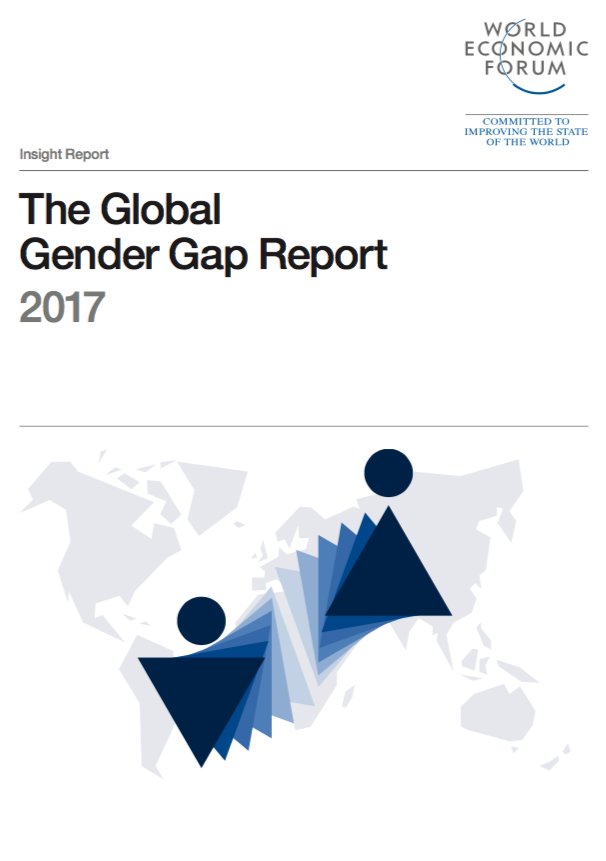The Global Gender Gap Report 2017
Posted by Share-Net NL on November 3, 2014 at 10:32 am


The Global Gender Gap Report, introduced by the World Economic Forum in 2006, provides a framework for capturing the magnitude and scope of gender-based disparities around the world. The index benchmarks national gender gaps on economic, political, education- and health-based criteria and provides country rankings that allow for effective comparison across regions and income groups and over time.
The Global Gender Gap Index was first introduced by the World Economic Forum in 2006 as a framework for capturing the magnitude of gender-based disparities and tracking their progress over time. This year’s edition of the Report benchmarks 144 countries on their progress towards gender parity on a scale from 0 (imparity) to 1 (parity) across four thematic dimensions—Economic Participation and Opportunity, Educational Attainment, Health and Survival, and Political Empowerment— and provides country rankings that allow for effective comparisons across regions and income groups. The rankings are designed to create global awareness of the challenges posed by gender gaps and the opportunities created by reducing them. The methodology and quantitative analysis behind the rankings are intended to serve as a basis for designing effective measures for reducing gender gaps. The methodology of the Index has remained stable since its original conception in 2006, providing a basis for robust cross-country and time-series analysis.
The 2017 Report’s key findings are:
- Weighted by population, in 2017, the average progress on closing the global gender gap stands at 68.0%— meaning an average gap of 32.0% remains to be closed worldwide across the four Index dimensions in order to achieve universal gender parity, compared to an average gap of 31.7% last year.
- On average, the 144 countries covered in the Report have closed 96% of the gap in health outcomes between women and men, unchanged since last year, and more than 95% of the gap in educational attainment, a slight decrease compared to last year. However, the gaps between women and men on economic participation and political empowerment remain wide: only 58% of the economic participation gap has been closed—a second consecutive year of reversed progress and the lowest value measured by the Index since 2008—and about 23% of the political gap, unchanged since last year against a long-term trend of slow but steady improvement. Key Findings
- Despite this overall mixed picture and continued stalling of progress at the global level, the situation is more nuanced at the regional and country level. Out of the 142 countries covered by the Index both this year and last year, 82 countries have increased their overall gender gap score compared to last year, while 60 have seen it decrease. By contrast, last year’s Report found negative outcomes in more than half of countries surveyed. Moreover, as detailed in the Report, a number of countries and regions have crossed symbolic milestones on the path to gender parity for the first time this year.
- Although this year’s edition of the Global Gender Gap Index sees no new entrants to its top 10 list, there have been notable rank changes. The top spots continue to be held by smaller Western European countries, particularly the Nordics that occupy the top three positions, with two countries from the East Asia and the Pacific region, one country from the Sub-Saharan Africa region, one country from the Latin America and the Caribbean region, and one country from the Eastern Europe and Central Asia region also represented. All but three countries in the Index top 10 have now crossed the threshold of closing more than 80% of their overall gender gap—up from five both last year and in 2015.
- At a global level, in 2017 four regions have a remaining gender gap of less than 30%—two of which are crossing this threshold for the first time this year. Western Europe records a remaining gender gap of 25%, placing it ahead of North America, with a gap of 28%, Eastern Europe and Central Asia, with a gap of 29%, and Latin America and the Caribbean, with a gap of 29.8%. The East Asia and the Pacific region ranks ahead of Sub-Saharan Africa, with a remaining gender gap of 31.7% and 32.4%, respectively, and South Asia, with a gap of 34%. The Middle East and North Africa region, for the first time this year, crosses the threshold of having a remaining gender gap of slightly less than 40%.





